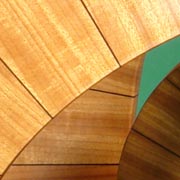A properly constructed glue joint will be stronger than the wood. The key to a strong joint is to orient the wood all in the same direction. The strongest glue joints are those that are made along the edge of the grain.
Wood changes dimensions significantly with changes in moisture and temperature. All of the wood that I use in my work has been kiln dried, and allowed to come to equilibrium for my shop conditions in northern Arizona.
The main thing to remember is that wood changes very little in the direction of the grain, and changes a lot in the direction perpendicular to the grain. You should never glue one piece of wood with the grain direction perpendicular to another piece. (Very short pieces would be OK, but not for distances longer than about 1/2 inch).
I take care in all of my sculptures to orient the grain in the same direction in adjacent pieces. This is also true of the very thin veneer pieces that give a "pin-striping" effect.
Sometimes, the geometry of a piece prevents you from always following this rule. For example, a segmented vase or bowl may have a solid base, and somewhere along it's perimeter it will have its grain perpendicular to the wood on the side. One solution is to have the base "floating" in a groove in the lowest segmented ring of the bowl/vase. This allows the base to expand/contract independent of the segmented sides.
Some woods (such as cocobolo and certain rosewoods) have such a high content of natural oil that glue will not adhere to the wood properly. These woods need to be avoided in segmented work. Also, some woods expand more than others. When planning the woods to use in a piece, they should all have a compatible range of expansion.
As with fine wooden furniture, the artist must plan the joints of segmented work. The result is a piece of art that will last for generations.

